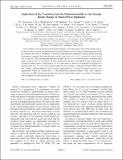Exploration of the Transition from the Hydrodynamiclike to the Strongly Kinetic Regime in Shock-Driven Implosions
Author(s)
Hoffman, N. M.; Amendt, P. A.; Atzeni, S.; Glebov, V. Yu.; Stoeckl, C.; Seka, W.; Marshall, F. J.; Delettrez, J. A.; Sangster, T. C.; Betti, R.; Goncharov, V. N.; Meyerhofer, D. D.; Skupsky, S.; Bellei, C.; Pino, J.; Wilks, S. C.; Kagan, Grigory Alexandrovich; Molvig, Kim; Nikroo, A.; Rosenberg, Michael Jonathan; Rinderknecht, Hans George; Zylstra, Alex Bennett; Li, Chikang; Seguin, Fredrick Hampton; Sio, Hong Weng; Gatu Johnson, Maria; Frenje, Johan A.; Petrasso, Richard D.; ... Show more Show less
DownloadPhysRevLett.112.185001.pdf (850.9Kb)
PUBLISHER_POLICY
Publisher Policy
Article is made available in accordance with the publisher's policy and may be subject to US copyright law. Please refer to the publisher's site for terms of use.
Terms of use
Metadata
Show full item recordAbstract
Clear evidence of the transition from hydrodynamiclike to strongly kinetic shock-driven implosions is, for the first time, revealed and quantitatively assessed. Implosions with a range of initial equimolar D[superscript 3]He gas densities show that as the density is decreased, hydrodynamic simulations strongly diverge from and increasingly overpredict the observed nuclear yields, from a factor of ∼2 at 3.1 mg/cm[superscript 3] to a factor of 100 at 0.14 mg/cm[superscript 3]. (The corresponding Knudsen number, the ratio of ion mean-free path to minimum shell radius, varied from 0.3 to 9; similarly, the ratio of fusion burn duration to ion diffusion time, another figure of merit of kinetic effects, varied from 0.3 to 14.) This result is shown to be unrelated to the effects of hydrodynamic mix. As a first step to garner insight into this transition, a reduced ion kinetic (RIK) model that includes gradient-diffusion and loss-term approximations to several transport processes was implemented within the framework of a one-dimensional radiation-transport code. After empirical calibration, the RIK simulations reproduce the observed yield trends, largely as a result of ion diffusion and the depletion of the reacting tail ions.
Date issued
2014-05Department
Massachusetts Institute of Technology. Department of Physics; Massachusetts Institute of Technology. Plasma Science and Fusion CenterJournal
Physical Review Letters
Publisher
American Physical Society
Citation
Rosenberg, M. J., H. G. Rinderknecht, N. M. Hoffman, P. A. Amendt, S. Atzeni, A. B. Zylstra, C. K. Li, et al. “Exploration of the Transition from the Hydrodynamiclike to the Strongly Kinetic Regime in Shock-Driven Implosions.” Physical Review Letters 112, no. 18 (May 2014). © 2014 American Physical Society
Version: Final published version
ISSN
0031-9007
1079-7114